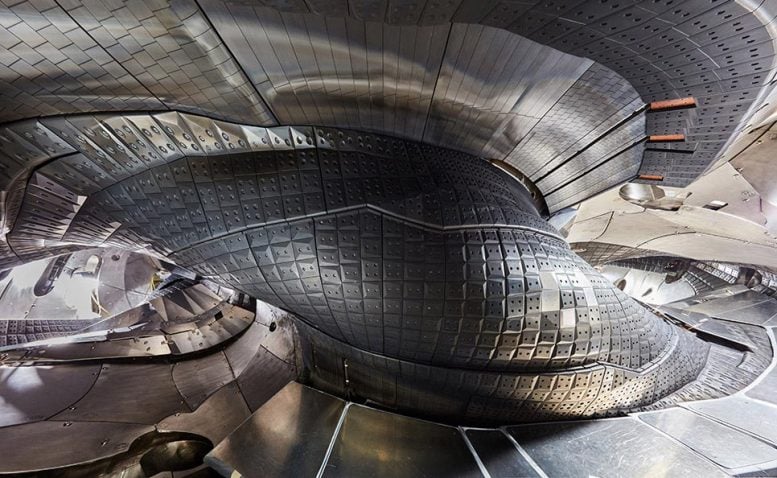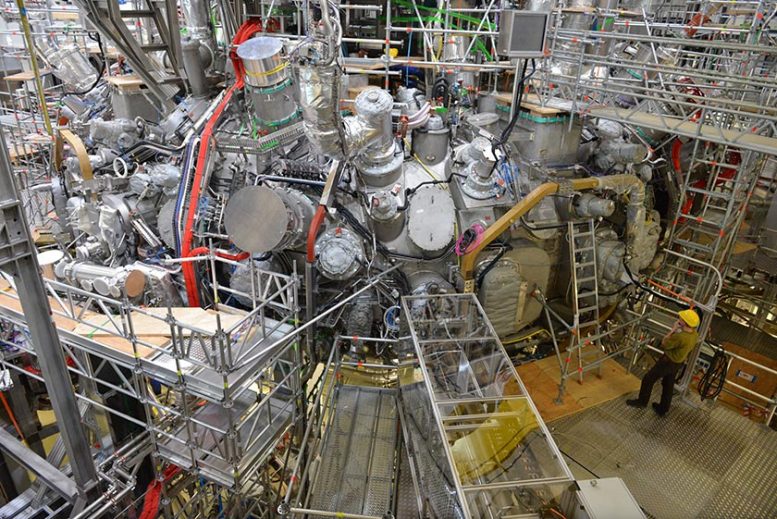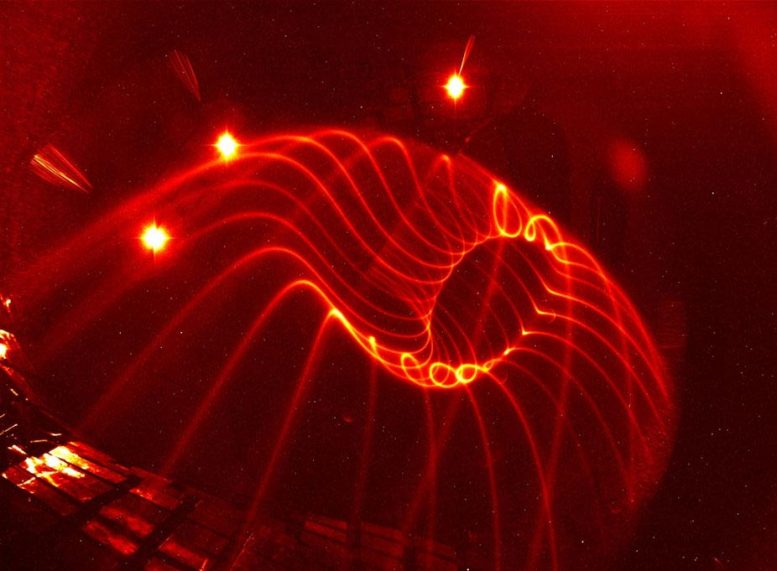
A key hurdle facing fusion devices called stellarators — twisty facilities that seek to harness on Earth the fusion reactions that power the sun and stars — has been their limited ability to maintain the heat and performance of the plasma that fuels those reactions. Now collaborative research by scientists at the U.S. Department of Energy’s (DOE) Princeton Plasma Physics Laboratory (PPPL) and the Max Planck Institute for Plasma Physics in Greifswald, Germany, have found that the Wendelstein 7-X (W7-X) facility in Greifswald, the largest and most advanced stellarator ever built, has demonstrated a key step in overcoming this problem.
Cutting-edge facility
The cutting-edge facility, built and housed at the Max Planck Institute for Plasma Physics with PPPL as the leading U.S. collaborator, is designed to improve the performance and stability of the plasma — the hot, charged state of matter composed of free electrons and atomic nuclei, or ions, that makes up 99 percent of the visible universe. Fusion reactions fuse ions to release massive amounts of energy — the process that scientists are seeking to create and control on Earth to produce safe, clean and virtually limitless power to generate electricity for all humankind.

Recent research on the W7-X aimed to determine whether design of the advanced facility could temper the leakage of heat and particles from the core of the plasma that has long slowed the advancement of stellarators. “That is one of the most important questions in the development of stellarator fusion devices,” said PPPL physicist Novimir Pablant, lead author of a paper describing the results in Nuclear Fusion.
His work validates an important aspect of the findings. The research, combined with the findings of an accepted paper by Max Planck physicist Sergey Bozhenkov and a paper under review by physicist Craig Beidler of the institute, demonstrates that the advanced design does in fact moderate the leakage. “Our results showed that we had a first glimpse of our targeted physics regimes much earlier than expected,” said Max Planck physicist Andreas Dinklage. “I recall my excitement seeing Novi’s raw data in the control room right after the shot. I immediately realized it was one of the rare moments in a scientist’s life when the evidence you measure shows that you’re following the right path. But even now there’s still a long way to go.”
Common problem
The leakage, called “transport,” is a common problem for stellarators and more widely used fusion devices called tokamaks that have traditionally better coped with the problem. Two conditions give rise to transport in these facilities, which confine the plasma in magnetic fields that the particles orbit.

These conditions are:
- Turbulence. The unruly swirling and eddies of plasma can trigger transport;
- Collisions and orbits. The particles that orbit magnetic field lines can often collide, knocking them out of their orbits and causing what physicists call “neoclassical transport.”
Designers of the W7-X stellarator sought to reduce neoclassical transport by carefully shaping the complex, three-dimensional magnetic coils that create the confining magnetic field. To test the effectiveness of the design, researchers investigated complementary aspects of it.
Pablant found that measurements of the behavior of plasma in previous W7-X experiments agreed well with the predictions of a code developed by Matt Landreman of the University of Maryland that parallels those the designers used to shape the twisting W7-X coils. Bozhenov took a detailed look at the experiments and Beidler traced control of the leakage to the advanced design of the stellarator.

“This research validates predictions for how well the optimized design of the W7-X reduces neoclassical transport,” Pablant said. By comparison, he added, “Un-optimized stellarators have done very poorly” in controlling the problem.
Further benefit
A further benefit of the optimized design is that it reveals where most of the transport in the W7-X stellarator now comes from. “This allows us to determine how much turbulent transport is going on in the core of the plasma,” Pablant said. “The research marks the first step in showing that high-performance stellarator designs such as W-7X are an attractive way to produce a clean and safe fusion reactor.”
References:
“Investigation of the neoclassical ambipolar electric field in ion-root plasmas on W7-X” by N. Pablant, A. Langenberg, A. Alonso, J. Baldzuhn, C.D. Beidler2, S. Bozhenkov, R. Burhenn, K.J. Brunner, A. Dinklage, G. Fuchert, O. Ford, D.A. Gates, J. Geiger, M. Hirsch, U. Höfel, Ye.O. Kazakov, J. Knauer, M. Krychowiak, H. Laqua, M. Landreman, S. Lazerson, H. Maaßberg, O. Marchuck, A. Mollen, E. Pasch, A. Pavone, S. Satake, T. Schröder, H.M. Smith, J. Svensson, P. Traverso, Y. Turkin, J.L. Velasco, A. von Stechow, F. Warmer, G. Weir, R.C. Wolf, D. Zhang and the W7-X Team, 20 February 2020, Nuclear Fusion.
DOI: 10.1088/1741-4326/ab6ea8
“High-performance plasmas after pellet injections in Wendelstein 7-X” by Sergey A Bozhenkov, Yevgen Kazakov, Oliver Ford, Marc N A Beurskens, Jorge Alberto Alcuson, J Arturo Alonso, Jürgen Baldzuhn, Christian Brandt, Kai Jakob Brunner, Hannes Damm, Golo Fuchert, Joachim Geiger, Olaf Grulke, Matthias Hirsch, Udo Höfel, Zhouji Huang, Jens P Knauer, Maciej Krychowiak, Andreas Langenberg, Heinrich Peter Laqua, Samuel A Lazerson, Nikolai B Marushchenko, Dmitry Moseev, Matthias Otte, Novimir Antoniuk Pablant, Ekkehard Pasch, Andrea Pavone, Josefine Proll, Kian Rahbarnia, Evan R Scott, Hakan M Smith, Torsten Stange, Adrian von Stechow, H Thomsen, Yuriy Turkin, Glen A Wurden, Pavlos Xanthopoulos, Daihong Zhang and Robert C Wolf, 20 February 2020, Nuclear Fusion.
DOI: 10.1088/1741-4326/ab7867
Pablant’s work was done in collaboration with more than three dozen coauthors from seven national and international institutions. These centers include the University of Maryland and Auburn University in the United States and the Max Planck Institute for Plasma Physics and the Jülich Supercomputing Centre in Germany; the National Fusion Laboratory in Spain; and the Laboratory for Plasma Physics in Belgium, representing the laboratories from the European Consortium of fusion laboratories (EUROfusion).
Support for this work comes from the DOE Office of Science and the Euratom research and training program.
Never miss a breakthrough: Join the SciTechDaily newsletter.
1 Comment
But didn’t we already know the turbulence arose at the edges?